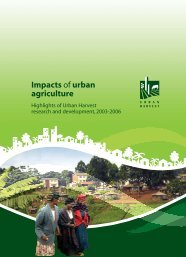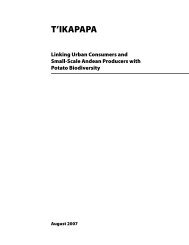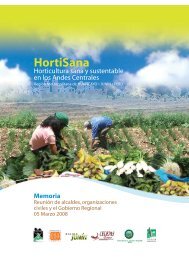Download pdf - International Potato Center
Download pdf - International Potato Center
Download pdf - International Potato Center
You also want an ePaper? Increase the reach of your titles
YUMPU automatically turns print PDFs into web optimized ePapers that Google loves.
CIP • SOCIAL SCIENCES WORKING PAPER 2010-1<br />
Table 5. Age of sample respondents in the households of ECA countries<br />
Country Burundi Ethiopia Kenya Uganda Rwanda All countries<br />
Buj Kay AA Na Aw Nb Msa Kla Kbl Ki Gis<br />
N 82 51 83 57 69 89 76 116 60 67 45 795<br />
Mean 38 35 32 42 32 39 59 35 34 43 43 39<br />
Minimum 15 13 19 22 23 11 16 18 18 32 30 11<br />
Maximum 75 70 60 61 53 55 85 60 60 55 51 75<br />
n= Sample size<br />
Buj – Bujumbura, Kay – Kayanza; AA – Addis Ababa, Na – Nazreth, Aw – Awassa; Nb – Nairobi, Msa –<br />
Mombassa; Kla – Kampala, Kbl – Kabale, Ki – Kigali, Gis - Gisenyi<br />
The mean ages were higher in the city areas that were designated consumption areas and they<br />
varied from 32 in Addis Ababa and Awassa (Ethiopia) to 59 in Mombassa (Kenya). The maximum<br />
age of respondents also had a similar trend with Gisenyi-Rwanda being lowest (51) and<br />
Mombassa-Kenya highest (85).<br />
4.3.2 Family sizes of households<br />
The average family size of the sample households among the high and low income groups of the<br />
respondents in Burundi, Ethiopia, Kenya, Rwanda and Uganda is seven and ranges from a mean<br />
of 2 to 14 (Table 6). The average family sizes of high income households are higher than those of<br />
the low income households. The size of family has a role to play in adopting technologies that<br />
require human labor. For instance, chips processing technologies require labor for washing<br />
potatoes, peeling, chips making and frying. Moreover, family size affects the demand for<br />
products. Large family size, especially children and youths in a household in urban areas, might<br />
imply more demand for chips and since the high income groups have larger households, this<br />
creates a higher demand for foods associated with the rich such as chips.<br />
Table 6. Family sizes of sample households in the ECA countries<br />
Country Burundi Ethiopia Kenya Uganda Rwanda<br />
HI LI HI LI Hi LI HI LI HI LI<br />
N 63 80 101 110 85 80 87 89 67 45<br />
Mean 8 7 6 5 10 7 7 5 7 6<br />
Minimum 2 2 2 1 1 1 2 1 3 3<br />
Maximum 20 18 12 12 19 12 13 12 9 9<br />
HI – High income, LI – Low income;<br />
4.4. Source and qualities of processing potatoes<br />
4.4.1 Sources of potatoes for chips processing<br />
Each country had specific varieties preferred for chips processing (Table 7) which, however, was<br />
affected by availability. In Ethiopia, 72% of the overall sample hotels purchase potatoes directly<br />
from wholesale vegetable markets, while 28% of the hotels get potatoes directly supplied to<br />
M A R K E T S F O R F R E S H A N D F R O Z E N P O T A T O C H I P S I N T H E E C A 13
















